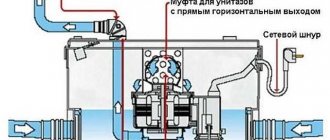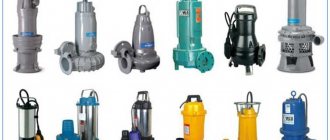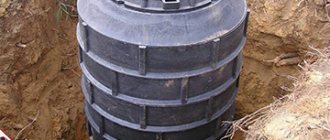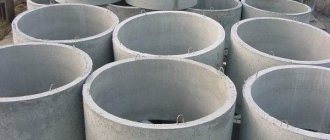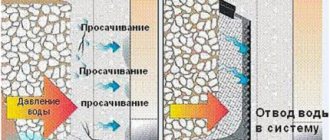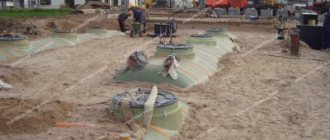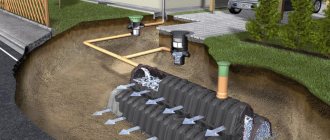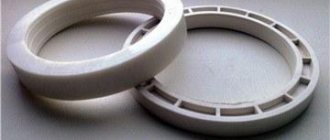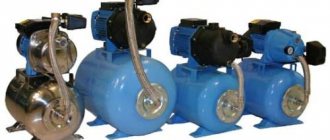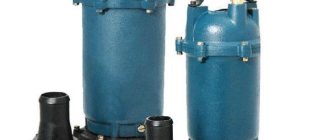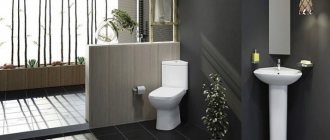Connection diagram and operating rules
Rice.
3 Electrical diagram for connecting wires in drainage pumps The connection diagram for a drainage pump in the absence of a plug or if it is necessary to extend the wire will not cause problems even for a housewife. All standard wires are color coded according to their purpose; simply connect wires of the same color.
Rice. 4. Connection diagram with a separate starting device
Before connecting the drainage pump and installing it to a depth, it is useful to observe the following rules:
- If we are connecting a pumping device for the first time, then before work we should study the drainage parameters and the characteristics of the power supply network for compatibility - this will facilitate its reliable connection to the network and grounding.
- Without an overheating protection relay, connection to the electrical network should be done through a circuit breaker, with a rated operating current of no more than its maximum value for the electric pump.
- A deep drainage system that has an electrical circuit with a built-in thermal relay can be connected directly to the electrical network. In this case, a situation may arise when the drainage pump overheats under intense load and turns off - in this case, it is necessary to give it time to cool down.
Rice. 5 How to connect a drainage pump - connection diagram
- Deep-well electric pumps have a cable with a length designed so that their immersion depth corresponds to the length of the electrical cord. If the cable is damaged or there is a need to replace it, it is prohibited to repair it by any means or change it yourself. This work must be entrusted to experienced specialists who will ensure complete sealing of the connection.
- When the pumps stop, there may be a reverse outflow of water from the pressure line to the source of water intake - this can lead to the tank being filled and the device being turned on again. To eliminate this effect, the submersible pump connection diagram must include a check valve that is connected to the pump outlet.
- When working with a deep drainage pump, it is necessary to ensure that the flow rate of the container with pumped water does not allow it to constantly turn on and off - this leads to its overheating and stopping.
Rice. 6 Drainage pump automation
The drainage pump has a built-in float switch and, in many cases, an overheat protection relay, so their installation and connection do not require complex automation. In the drainage connection diagram, a valve and a check valve are additionally installed in the pressure pipeline to prevent the reverse outflow of liquid.
Features of the design and installation of pumps
Due to the peculiarities of its design, a drainage pump for pumping water from a well can lift to the surface not only ordinary water, but also liquefied mud containing solid inclusions with a diameter of 2.5 to 3.5 cm.
It functions as follows:
- The pump, mounted on a special base stand for better stability, is lowered to the bottom of the well.
- From there, its pressure hose is directed towards a trench or ditch designed to drain water from the water intake point being cleaned.
- The pump turns on and runs until the well is completely cleaned.
The design of this unit consists of the following elements:
- Pump housing (made of cast iron, stainless steel or plastic).
- Electric motor.
- Pumping unit.
Liquid suction in such a pump is carried out through a pump unit grid equipped with holes, the diameter of which has a direct effect on their throughput. That is, if necessary, you can choose a unit for yourself that can pump out water with solid particles of various diameters.
In addition, many devices of this type are equipped with special devices - float switches, which automatically turn off the pumps when the pumped water level drops to a certain level.
A submersible pump for pumping dirty water is installed directly into the well
How to choose?
First of all, you should study the characteristics:
- Power.
- Performance.
- Pressure force.
- Working conditions.
- Temperature conditions and so on.
We invite you to consider the main technical characteristics that will help you make the right choice of a surface or submersible device.
| Performance | This is the volume of liquid pumped per hour, measured in cubic meters. You can find out about this in the device passport. For domestic purposes, a capacity of up to 10 cubic meters per hour is sufficient |
| Pressure force | Depending on the model, the pressure force is from 5 to 50 meters. This indicator is indicated in the passport. It indicates the distance to which the pumped water can be transported. |
| Working conditions | Before choosing a submersible or surface unit, it is necessary to determine the nature of the liquid being pumped out. If the device is planned to be lowered into a reservoir, then there must be a solid base under it - for example, immersed in a bucket or other container. The temperature of the pumped liquid, water quality, presence of impurities, etc. are also taken into account. |
| Automation type | The drainage pump design almost always includes an automatic control unit. For example, a pump with an internal float. There may also be electronic control. Availability of dry-running relay or thermal relay |
Advice! If you are interested in a powerful device, then this will be displayed on its technical characteristics. Take the maximum numbers and equipment from our table, and this will allow you to choose a high-quality household drainage system.
What to look for when choosing
Drainage view
One of the main criteria for choosing such a unit is the degree of contamination. As a rule, this parameter is determined by the maximum size of contamination particles that the pump can “digest.”
The criterion is the depth of the well. The larger the parameter, the more performance the pump needs to successfully lift water.
The final, but also important factor is the design features of the equipment. These include the location of the suction hole, the material from which the device body is made, and maintainability. This factor is little influenced by the conditions in which the pump will operate; for the most part, they affect the performance of the device, and very much depend on its price and manufacturer.
Review of the best equipment
Model NPC – 400D
Let's take a closer look at specific pump models. First, let's look at the submersible centrifugal pump NPC - 400D, from the Chinese company Kalibr. The power of this model is 400 W, the productivity is about 7000 l/hour, and it is capable of working at a depth of up to 7 meters.
The size of the passed particles is 5 mm. Made from cheap plastic. Weight is 5 kilograms. It is distinguished by its simplicity and relatively low price - a little more than 2,000 rubles. Cheap, unpretentious, perfect for a summer cottage.
Now, for comparison, let’s look at the German submersible drainage pump SDP 7000 from the well-known company Karcher. With a lower power of 320 W, this unit has the same performance (about 7000 l/hour) as the Chinese one. However, it surpasses it in immersion depth - it is able to cope with a distance of 8 meters. And also in terms of the maximum size of solid particles, this device is able to cope with pollution with a diameter of 20 mm. It also surpasses its predecessor in performance characteristics. In the equipment of this brand, everything is thought out to the smallest detail.
Model SDP 7000
Its body is made of high-quality, ultra-durable materials. It is equipped with a comfortable, ergonomic circular handle that allows you to carry it comfortably
You should also pay attention to the optimized connecting pipe, which allows you to connect any hoses, including large ones, without adapters.
This device is equipped with a float switch with an adjustable level, which allows it to be used in automatic mode.
Perhaps its only drawback is the price, 5,000 rubles, but is this a lot for all the listed advantages? You decide.
Necessity of equipment and operating rules
The desire to have a source of clean water in your home leads to considerable expenses for its maintenance. Regular cleaning alone can require large investments. But they can be significantly reduced if you use a pump to clean wells. Well drainage pumps are suitable for this purpose. However, only a properly selected pump can work effectively.
Thanks to regular use of such equipment, you can achieve amazing results and use exceptionally clean water. But for this it is necessary to comply with the requirements specified in the operating instructions. After all, as a rule, submersible equipment is used for such purposes, the serviceability of which is simply impossible to visually check.
This feature requires good tightness, for which the pumps of these models have a special chamber filled with oil, which protects the unit’s engine from contact with water. It should be regularly checked to ensure that it contains the required amount of the composition and, if necessary, topping up.
After long-term operation of the equipment, the oil must be replaced; this process is usually performed after 200-250 hours of operation.
Only by following all these rules will you be able to ensure long-term and reliable operation of the pump for cleaning wells.
Conclusion
Having considered all the features of drainage equipment, you can easily select a model that meets your specific requirements. If it is intended to be used seasonally at the dacha, then you can limit yourself to an inexpensive domestically produced pump. For permanent residence outside the city, you will need a more powerful and at the same time expensive model. But in any case, you should not purchase equipment from unknown companies; very often it turns out to be of low quality. By saving on it, you risk getting untreated water that is unsuitable for food.
Criterias of choice
To purchase a drainage pump that will not be useless due to technical limitations, it must meet the requirements and effectively perform the tasks assigned to it. When purchasing, consider the following nuances:
- You should not purchase a pump that is too powerful, as this will affect the amount of electricity consumed. It will heat up quickly. When working “idle”, parts wear out faster. Typically, drainage pumps intended for domestic purposes operate on a regular 220 Volt network, with a power of 400 W.
- It is necessary to take into account the coefficient of the generated liquid pressure at the outlet. It is usually measured in meters of water column, in bars or technical atmospheres. The pressure should not only ensure that water rises to the surface, but also help overcome the hydraulic resistance of horizontal pipes.
- Maximum immersion depth of deep-well drainage pumps.
- The productivity of a water station depends on the speed of water pumping.
- Not all equipment is designed for pumping liquids with large solid impurities and high concentrations.
When purchasing equipment, you need to carefully study the features of operation and maintenance. The following materials are used for the production of modern pumping stations:
- Plastic is the most budget option, the service life of which is relatively short.
- Stainless steel is a durable material that is resistant to mechanical stress. The service life usually exceeds 10 years.
- Cast iron is a high-quality material, but it is used less often for the manufacture of cases because it is heavy and expensive.
Most often, drainage pumps are made with a plastic body and a steel wheel. Such models combine high quality and affordability. Recently, pumps with working blades made of polymer have been introduced to the market; they are even cheaper than their counterparts.
It is recommended to purchase drainage pumps with a float from official representatives or in specialized large stores. When making a purchase, check the availability of components, documentation and study the terms of the warranty.
One of the optimal and effective solutions to combat frequent flooding of basements is the use of drainage pumps. Their advantage is that the connected submersible electric drain can be used in everyday life for various purposes. Therefore, you need the correct connection diagram for the pump and its correct connection, depending on the operating conditions and the tasks being solved.
Well cleaning procedure
Naturally, there is no point in using drainage equipment designed for pumping clean water. According to the diagram, for cleaning a well, it is best to use models that:
- have maximum power;
- allow liquid to pass through along with fibers and small contaminants;
- have special wheels that crush the largest particles of silt, dirt and other debris;
The ideal option is when the drainage pump is equipped with a float mechanism to adjust the immersion depth. In this case, there is completely no need to control the cleaning process of the structure (this is done when overheating of the equipment cannot be allowed).
According to the instructions, cleaning a well with a drainage pump consists of the following steps:
- measuring the distance to the bottom;
- immersion of the pump at a level of 0.6-0.8 m from the bottom;
- its inclusion;
- pumping out dirty water;
- natural supply of clean water from the aquifer;
- destruction of silt at the bottom (when clean water flows in);
- turning off and raising the pump;
- removing dirt from the equipment filter;
- re-immersion and cleaning of the well.
The duration of well cleaning is within 5-6 days, frequency - once every 3-7 years.
To clean the well from sludge, you can use a conventional electric pump. The only condition is the implementation of its modernization:
- cover one end of the pipe with a protective mesh;
- equip the second end of the pipe with a receiving pipe, to which a reliable cord is tied;
- the pump body is installed and fixed to a wooden pole (a metal plate, bolt and nut are used as fastening elements).
The pump is immersed by lowering a pole and rope. Water is pumped out until the bottom appears. The equipment body must be in the water. Using a rope, you can adjust the angle of the pump when you have to remove sludge from the walls of the well.
The process of pumping dirty water is subject to control
Particular attention is paid to changing the sound of equipment operation. This may occur due to the accumulation of a large amount of sludge on the protective mesh or the drainage pipe descending to the bottom
Video on how to clean a well:
Malfunctions and ways to eliminate them
There are a number of opportunities to repair the equipment yourself, provided that the broken part can be replaced with a new one or a simple technical procedure can be performed (for example, cleaning). To do this, you will have to disassemble the case, perform diagnostics, identify the problem and select an identical part.
Available actions include replacing the capacitor, impeller or float, repairing the electrical cable, fixing the shock absorber, and removing large pieces of clay and sand stuck inside the housing.
If the cast iron body is cracked, the valve has failed, or the winding has stopped functioning, you should contact a service center or think about buying a new pump. Inexpensive drainage devices made in China are inexpensive, so it is not advisable to order serious professional repairs.
Failure #1 – the power cord is faulty
The flexible element - the cable - is always at risk, since due to regular twists and kinks (which often happens during transportation and reinstallation of equipment), the wires under the layer of plastic or rubberized protection are torn, resulting in the power supply to the pump being cut off.
It is necessary to find the break point and make a connection. This operation is easy to carry out if the break occurs near the plug - you just need to clean and connect the wires, finally carefully insulating the work area.
A cable break in the pump connection area requires more time to repair. First, you need to remove the equipment from the water, wipe and dry it, then disassemble it to get to the internal connection unit. Get ready for the fact that instead of hexagonal holes you will encounter triple ones, which will make it difficult to select a screwdriver.
The cover should be removed carefully, without jerking or effort. By unscrewing the bolts holding the tension element, you can examine the cable and determine the area of \u200b\u200bthe break. We remove the worn piece, mount the cable in its original place, attach the tension element, and fix the bolts.
Failure #2 – water supply stopped
The engine is running properly, but the fluid has either stopped flowing altogether or is flowing in small uneven jerks.
There may be several reasons for this strange phenomenon:
- Part of the supply line is clogged. This is an outlet pipe or supply pipe. A kind of blockage arose from tufts of algae and pieces of clay. It is necessary to disconnect the pipes and clean them. It is possible that the pipe length is longer than recommended by the manufacturer, and therefore there is not enough pressure to deliver the required power.
- The impeller is worn out. Blades are bent or damaged. You should disassemble the device, replace parts, first visually (as far as possible) determining the cause of the malfunction.
- The fluid is oversaturated with dirt and debris. Therefore, the water has a thick consistency and is difficult to pump. We solve the problem by raising the suction hole a certain distance from the bottom, where sediment accumulates.
- Engine power has noticeably decreased. What can be determined even by sound. There may be problems with the electrical supply, failure of bearings, or depressurization of the oil compartment. It is necessary to disassemble the case to determine the cause of the breakdown and replace worn parts.
The most common problem is a clogged filter. To clean the screen and suction port, you can try running some clean water through the pump. If this procedure does not help, you should disassemble the housing and clean all chambers, removing pebbles, algae and wood chips.
When disassembling the unit, be sure to use the manufacturer's diagrams or instructions. They will help you remove parts sequentially and quickly find the bolt attachment points. In some cases, worn fasteners or loose nuts cause parts to become misaligned, which also affects the performance of the machine.
Failure #3 – the engine does not start
You connect the power supply - but the pump does not work, does not make noise and does not pump water. Be prepared to have to examine all the equipment.
Precautionary measures
If the surface of at least one of the concrete rings shows signs of contamination, deposits, or changes in color, it needs to be cleaned as soon as possible. This can be done at any time of the year, even in winter
But it is important to remember that cleaning wells is a much more serious procedure than going to the store or riding a bicycle. At least three people must start work at the same time
When descending into the well, they must be tied with a safety rope.
Before going down, it is worth checking whether dangerous gases have accumulated below. This is done by lowering a bucket containing a burning candle; deviation of its flame to the side, extinction or change in color of the fire indicate danger. Experienced specialists always go down wearing a helmet and wading rubber boots. For those suffering from heart and vascular diseases or periodic dizziness, it is better not to climb into wells, especially if the depth exceeds 3 m. You should definitely get a rope or simple ladder, having first made sure of their reliability.
In such a situation, as well as when the well is saturated with carbon dioxide and toxic fumes, it is better not to try to do the work on your own. It would be much more correct to call qualified specialists. It is not recommended to stand at one point for a long time; this may result in your legs being sucked in. It is recommended to place a wooden platform in case of muddy or waterlogged soil, this will help distribute the weight evenly.
Unless absolutely necessary, it is better to refrain from cleaning the well in the dark. If you notice objects falling from above, including tools, it is better to press yourself against the wall. You can only be downstairs alone.
It is advisable to limit the time you work on the bottom to 15 minutes with rest at the top for at least the same amount of time. If it is necessary to illuminate something, only special lanterns are taken into the well, which are made according to an explosion-proof design. They must be turned on and off strictly before and after descent. It is strictly forbidden to smoke or drink water downstairs. Do not trust well cleaning to minors.
For more information on how to clean a well with your own hands, see the following video.
Application area
The operating principle of an electric drainage pump corresponds to centrifugal types; it is distinguished from submersible devices for collecting water from great depths by some design changes. Electric drainage pumps can be used for the following work:
- Pumping water from any depth in case of flooding of premises below ground level: basements, cellars, warehouses, storage facilities, underground garages.
- A drainage pump can pump out water from swimming pools, ponds and artificial reservoirs when they are contaminated; with their help, you can quickly fill the reservoir again.
- Using a drainer, it is convenient to water plants in garden plots directly, or by filling large containers for further drip irrigation.
- Temporarily use instead of a deep-well pump to collect clean water, but it should be taken into account that the efficiency of a drainage pump is significantly less than special electric pumping equipment for water supply.
- It is convenient to use a submersible electric pump to pump water out of drainage pits inside and outside buildings in automatic mode - when connected, they begin pumping water after filling the pit to a certain level and stop working after it is emptied.
- Due to their design features, drainage pumping devices are used to clean wells, wells and ponds - they operate at great depths and are capable of sucking out dirty water with large fractions.
- If necessary, the drainer can be used not for its intended purpose, but as an electric fecal pump for cleaning sewer, cesspool and waste pits from heavily contaminated waste. The device does not have a shredder, so it will have to be connected through an additional filter.
Types of well cleaning equipment
To clean the well with your own hands, you can use either a submersible or surface drainage pump.
Submersible pumps lower water. This equipment is characterized by:
- increased productivity;
- long operational period;
- small in size;
- light weight;
- versatility (used both for pumping dirty water and pumping clean water);
- presence of float protection.
The disadvantages of submersible pumps include:
- impossibility of pumping water from a depth of more than 20 m;
- insufficient water pressure;
- lack of water purification function.
Advantages of a surface mounted drainage pump:
- maximum powerful pressure;
- increased reliability (does not come into contact with water);
- uninterrupted operation throughout the day;
- the ability to install equipment anywhere on the land plot;
- affordable price.
"Disadvantages" of surface pumps:
- too noisy work;
- impossibility of pumping water from a depth exceeding 8 m;
- availability of technical skills related to the operation of equipment (checking the correct rotation of engine elements, high-quality connection of pipes).
Distinctive features
Pumping equipment for dirty water belongs to the drainage category, and its use is similar to the use of fecal pumps. However, there are some differences:
- To a greater extent, fecal units are designed for viscous wastewater with fibrous organic inclusions, for the pumping of which a grinding mechanism is provided.
- The drainage pump, on the contrary, is not designed to operate in liquid conditions saturated with organic inclusions. At the same time, a drainage pump for sewage allows you to pump wastewater containing insoluble large fragments - pebbles, sand, silt of a certain size. As a rule, the permissible size of inclusions is indicated in the product passport.
Types of equipment
Drainage pumps are divided into two types according to the type of immersion:
- superficial;
- submersible
Example of a surface horizontal pump
Surface models are designed for servicing wells on the surface. They are unpretentious in installation and maintenance.
The device is capable of working with slightly contaminated water and liquid containing small debris particles. Surface sump pumps for pumping water from a well are specially designed to collect muddy water. Surface models are centrifugal, which are divided into single-stage and multi-stage. They are not suitable for pumping dirty water with small impurities.
Vortex surface devices are suitable for pumping water without serious contamination. Self-priming surface devices are capable of sucking almost pure liquid with air. Using liquid ring pumps, you can even pump fuel and fuel oil.
When servicing a surface device, it will be enough to lubricate its working parts and replace parts if necessary. Drainage devices of this type are capable of lifting water from a depth of 8 meters.
For wells with a depth of more than 10 meters, it is recommended to use submersible options. These devices work in the water itself and do not make noise. The only thing is that during maintenance it is necessary to pull them out of the well. Submersible pumps operate automatically and turn off when the water level drops.
The photo shows three submersible pumps of the same series
A submersible well sump pump is an excellent choice for pumping water from deep containers. It will last a long time without repair. The device is easy to carry and install. To increase the service life, you should choose devices that draw water from the top of the housing.
Submersible models are highly efficient and quickly respond to changes in water level.
What is a clean water drain?
It is designed to pump out lightly polluted reservoirs, pits, wells and other things. Some types of submersible pumps are capable of pumping liquid with inclusions up to 40 mm in diameter. It is not recommended to use pumps for purposes other than their intended purpose, such as pumping feces. It will fail.
The drainer is capable of working exclusively in lightly polluted places. If the pumped liquid contains large inclusions, then the equipment must be equipped with a grinder; by default it does not have this.
How to know when it's time to cleanse.
The main indicators of source contamination is a violation of the characteristics of the liquid.
Leaves indicate that the owners are not taking good care of the mine.
The most common ones are:
- The water loses its transparency. Different levels of cloudiness can be caused by depressurization of the connecting joints of the rings. Bottom filters become clogged with small particles of earth and clay.
- Presence of foreign objects. Garbage, leaves, etc. The absence or damage to the mine hatch is responsible for this. The well must be protected from dust and debris.
- The water darkened. Darkening of the liquid indicates infrequent operation of the well. There is no natural renewal, water stagnation occurs and pathogenic bacteria actively multiply.
- Acquiring a green tint. The reason is the active development of small algae. When sunlight enters the mine, microorganisms grow, turning the natural source into a swamp. The reason for this is a loose fit of the lid.
- An admixture of rust. Brown shades indicate excess iron levels. If such water is allowed to sit, a reddish coating will form on the surfaces of the vessel. The natural cause is an incorrectly calculated fluid intake level. Regular well cleaning will not fix this. Additional filtration systems will be required.
- Foreign odor and taste. Depressurization of the mine and, as a consequence, the influx of wastewater, lead to an unpleasant odor and taste.
Cleaning begins after identifying the source of contamination.
Vibrating
Comfortable vibration devices are the best known. They have been used in suburban areas for many years. When assessing how to choose a pump for a well, it is worth considering that this option, due to vibration, raises turbidity from the bottom of the source used, which leads to its rapid clogging. For this reason, they need private cleaning.
At the same time, the vibration pump for a well is attractive due to its ease of operation. For many years, this option has enjoyed consistently high popularity due to its resistance to abrasives. A unit of this type is ready for successful operation in a well structure, the water in which has a large amount of suspended matter, without requiring repairs or replacement of parts.
Installation nuances
Surface well sump pumps are installed near the well. The territory for them should be maximally insulated and protected from the effects of natural precipitation.
Before installation, you must check the device and carefully read the instructions.
A hose is connected to submersible models and a check valve is installed, which does not allow water to return.
Then they are simply lowered into the well and installed in a vertical position. Next, the device is connected to the network.
In addition, the submersible apparatus needs to be grounded. To protect the device from rapid contamination, a metal sheet or wooden strip is placed under it. This will prevent sludge from being sucked in. If used incorrectly, pumps quickly become dirty. For cleaning, the body and parts are washed with clean water.
How to choose a drainage pump for a well - useful tips
When choosing a drainage device, you should not rely only on price. It happens that a drainage pump for a well, the price of which is cheaper, works better than expensive models.
When purchasing a device, we advise you to pay attention to water pressure and performance. Productivity refers to the volume of water that is pumped by the device per hour.
Water pressure summarizes several indicators: the depth of placement of the liquid and the distance where it is necessary to pump out the liquid
Productivity refers to the volume of water that is pumped by the device per hour. Water pressure summarizes several indicators: the depth of liquid placement and the distance to which the liquid needs to be pumped out.
Before purchasing, you should also decide on the purpose of using a drainage device, since there are devices for pumping out clean water that are not at all suitable for working in sewers and drainage pits.
Advice. To make sure you don’t make a mistake with the device, it is better to choose a drainage-fecal option that can cope with viscous liquids and large particles in the water.
The submersible model must have a float that reacts to the water level. A device without a float will fail faster. For the drainage device, you should purchase a special hose. The depth of the well plays an important role. The model of the drainage pump depends on this value.
The drainage pump is an easy-to-install and operate device. Before purchasing it, it is enough to answer the question about its purpose.
For each goal, you should choose your own option. For liquids with light contamination, a surface or submersible pump is suitable. For more contaminated liquids with the presence of large particles, choose a drainage-fecal apparatus that is capable of grinding small stones.
Unit selection
The selection should be made depending on where the drainage pump is planned to be installed (in a well, septic tank, basement, etc.). It is advisable to install this type of equipment in a pit with a depth of 400 to 600 mm. This will protect the basement from water ingress.
Additionally, the unit can be equipped with a vertical float mechanism, which will start the pump as the recess is filled, while the floor remains dry.
If it is necessary to drain the tank as much as possible, install the drainage pump in the well on a hard surface. In this case, the unit will start when the drainage rises a few centimeters.
Let's look at the types of drainage pumps for a well
Submersible. The unit is lowered to the bottom of the shaft to clear quicksand. It is actively used by summer residents and residents of private sectors, as it has an affordable price, is easy to operate, and can be installed independently.
It is divided into two subtypes: vibration and centrifugal.
Surface. It is used on the surface, and I lower only the pressure hose into the well.
Difference between submersible and surface pump
Submersible drainage pump
The advantages of this unit include:
- small size and weight;
- long period of use;
- used for pumping clean and contaminated water;
- high performance;
- The pump system has an automatic mode.
Disadvantages of submersible pumps:
- relatively weak water pressure, the maximum height of water rise for some types of units is 20 meters;
- Dirty water is not purified when rising, and therefore it is not always appropriate to use it for organizing water supply systems.
The work is carried out using a submersible drainage pump
Vibrating submersible pumps are used in the summer season to supply clean water. Such a unit is not suitable for installation in a well on quicksand, as it provokes the movement of the sand mass at the bottom.
However, summer residents often choose the “Malysh” pump for cleaning a quicksand well, since the low cost and availability of replacement parts allow for repairs in case of breakdown after heavy loads.
The centrifugal unit can be used for deep wells. It provides water pressure up to 60 meters and has high performance. This is an excellent example of a pump for a quicksand well, as it does not cause vibrations or rise of sand. But if the operating rules are not followed, an oil spill may occur on the surface of the water.
Selection of pumping equipment for permanent and temporary use
Owners planning to install a pump in a country well with their own hands must determine how the equipment will be used: during only the summer season or year-round. For occasional short-term use, you can choose budget models of surface, submersible or semi-submersible devices. If you need to provide water to a residential building, you should prefer silent deep-water equipment.
Surface pumps are mobile and easy to install
There are several types of equipment, both submersible (installed directly under water) and surface (installed on the ground surface) type. Depending on the purpose of the devices, 3 groups can be distinguished:
- Borehole and sump pumps for clean water.
- Drainage equipment: devices that can be used in dirty environments, for pumping out liquid after floods, and cleaning drainage systems.
- Fecal pumps. They are used in septic tanks, cesspools, and sewage tanks.
Sewage pump with float chamber
Drinking water supply devices are designed for use in clean environments with a small amount of fine particles. The presence of a small amount of sand in the water is allowed - up to 200 g per cubic meter of pumped liquid.
The drainage pump, which can be installed both in a sewer well and in a flood-filled basement, copes with dirty water: the presence of medium and large particles with a diameter of up to 12 - 15 mm is allowed. Used for regular drainage of drainage systems. Fecal devices are used in contaminated liquid environments without large solid particles.
The performance of the equipment depends on the operating principle. Pumps are produced:
- Vibrating type.
- Centrifugal.
- Vortex.
Centrifugal deep-well pumps are ideal for organizing a reliable water supply system. The equipment operates almost silently, only the clicks of the relay, which controls the operation of the device’s motor, can be heard. Such pumps are installed in deep productive wells and wells
When choosing equipment, you need to pay attention to the dimensions. The pump must be constantly completely submerged under water, the minimum distance to the bottom is 1 m, and at least 1 - 1.5 m to the surface of the water
Equipment for wells is produced with a shortened body
The pump is equipped with a check valve and a float protection system. Usually 2 cameras are connected: one controls the lower level, the second controls the distance from the top of the pump to the water surface. Select the device after calculating the required power. It is necessary to accurately predict water consumption. The number of water points is summed up and multiplied by the average flow rate of each tap. In addition, the required pressure is calculated - the height of the water column that the pump must produce. The height of the extreme points of water intake is added to the depth from which water is drawn. Another 20 - 30% is added, depending on the length of the pipeline, based on the calculation: every 10 meters of horizontal pipe is 1 m of pressure.
In most cases, to organize uninterrupted water supply to a single-family home, medium-power equipment with a capacity of up to 2–4 cubic meters/hour and a column height (pressure) of up to 40–60 m is sufficient. After determining the parameters and selecting the pump model, they plan how to install the pipes and secure them pump in the well.
Vibration pumps are an inexpensive analogue of full-fledged submersible devices. The main advantage is low price and versatility of use. The principle of operation is simple: water is sucked through the inlet after the rod is raised due to the transmission of an electromagnetic pulse. The equipment is suitable for one-time use and the organization of seasonal irrigation systems. Can be used in contaminated water for pumping it out.
Pumps of this type are not used for arranging a permanent water supply due to poor performance and unreliability.
